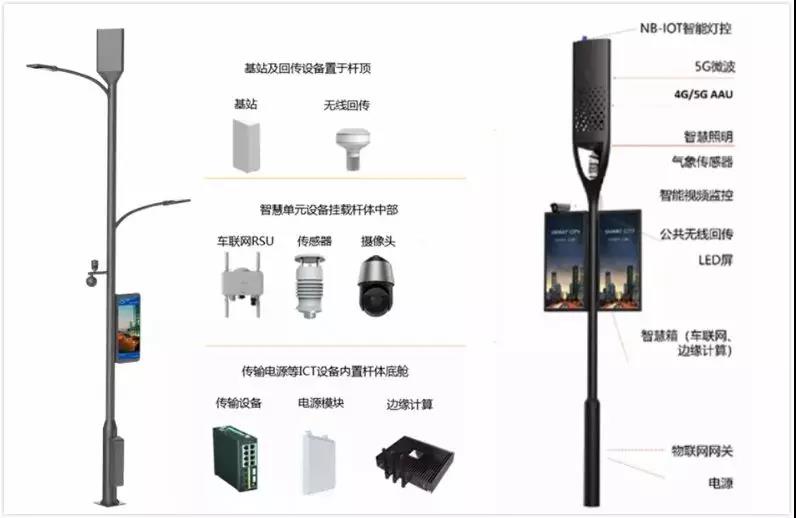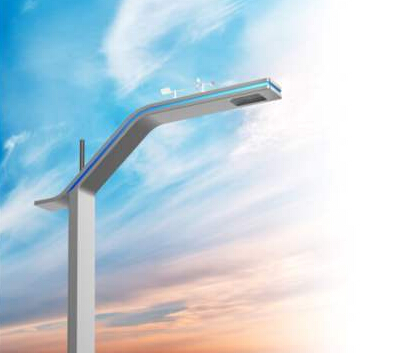The fifth generation of mobile communication technology (5G) has begun construction and is the basic support for Industry 4.0. With the acceleration of the application of 5G technology, the number of 5G sites will increase exponentially, and the smart pole is an ideal site resource with wide coverage and even distribution. At the same time, as an important carrier for the construction of smart cities, the application of smart poles is increasing, and the hardware stack on the pole should be standardized and systematic to meet the needs of decoupling, interoperability, and cost reduction. This article analyzes the requirements of mobile communications, "multi-pole integration", and smart cities for smart poles, and from the perspective of mobile communication base station construction, discusses the basic capacity requirements for 5G construction, and gives suggestions for standardization of smart poles.
As the 5G commercial era comes, leading ICT countries around the world are actively planning and guiding the integration of 5G and public facilities, which has directly promoted the development of smart poles.
The German Federal Government's "5G Strategy for Germany" [1] clearly states that the city's existing bearing facilities, such as light poles and traffic poles, will be an important part of 5G.
The Ministry of Science and ICT of South Korea pointed out that the relevant departments of the 17 administrative regions of South Korea must be prepared (power supply, transmission, etc.) so that 5G equipment can be installed on light poles and traffic poles [2].
The United States Federal Communications Commission (FCC) stated in the "FCC's 5G FAST Plan" that the FCC will reduce the approval process for the deployment of 5G miniaturized base stations on public facilities.
More and more local governments in China are aware of the important role of smart poles and are actively promoting the healthy and orderly development of the smart pole industry at the policy level [3, 4].
At the macro business level, the smart pole has changed the traditional light pole model, and its application involves multiple government departments and cross-industry entities. Its investment, operation, management mechanism and multi-party business model are still being explored. It lacks a unified smart pole infrastructure operation. Fang has become an important factor restricting the development of smart pole scale construction.
At the same time, at the technical standard level, the current smart pole lacks a unified and effective planning, causing repeated construction and waste of resources, such as the city's multiple poles and repeated road excavation. The lack of a unified technical reference for the smart pole project has led to constraints on some functional evolutions and difficulties in interconnection and data sharing among various business components.
To this end, accelerating the establishment of unified standards and specifications for smart poles, building demonstration models of smart poles with a certain scale, and realizing value-added through market testing of business models and cross-sectoral and cross-industry will be the focus of the next stage of smart pole industry development.
Demand analysis of smart rod
From street lights to smart poles, it's not a simple feature stack. At this stage, there are three main directions to promote the construction of smart light poles. The three directions have slightly different concerns on smart poles.
1. Demand for 5G sites
As the fifth generation of communication technology, 5G is considered to be the beginning of the Internet of Everything. The business potential inspired by higher network speeds (eMBB), reliable low latency (uRLLC), and massive Internet of Things (mMTC) is huge. However, due to the increase in speed and frequency band, under the same configuration and the same environment, the transmission distance of 5G signals is reduced compared to 4G signals.
The mobile communications industry must improve 5G coverage through a variety of means, including multi-antenna technology, decoupling of uplink and downlink frequency bands, and the addition of miniaturized sites. In dense urban areas, mobile network traffic is unevenly distributed, and the experience of "busy" traffic is easily challenged. At the same time, in residential areas, densely populated commercial areas, and some areas with high environmental protection, the macro site is difficult to obtain and it is prone to "blind" spots. After the reconstruction of 5G macro stations is completed, the “busy + blind” areas and the “thousands of industries + 5G” factories and parks will usher in the peak deployment of pole stations, and the number of 5G miniaturized sites will double.
The deployment of 5G pole stations will be carried out gradually, so new smart poles are needed to reserve equipment mount interfaces, power access, and large bandwidth transmission. The most important one is that for the selection of 5G equipment, in addition to considering lightness, it is also required to ensure tens of watts of power to increase coverage and maximize the value of a single pole.
2. The need for intensive construction-"multi-in-one"
At present, there are a variety of poles such as street light poles, power poles, monitoring poles, traffic signs, and billboards. The problem of large numbers, miscellaneous types, and disorderly installations is becoming increasingly prominent. Especially at the intersection, the condition of "pole forest" appeared, affecting the city appearance and wasting public resources. In order to achieve "sharing, intensive, overall planning" of resources and reduce the cost of urban construction, the multi-city city administrations have begun to implement the "multi-in-one" program.
3. Demands of smart cities
With the increasing number of urban residents, “urban diseases” such as traffic congestion, environmental pollution, and waste of resources continue to appear. "Smart cities" have emerged as a solution to urban diseases. Smart cities integrate artificial intelligence, Internet of Things, 5G, big data, cloud computing, and edge computing technologies to turn the entire city into a complete neural and memory system that digitizes, collects, stores, and analyzes human behavior to obtain the most Excellent solution.
Multi-functional, multi-sensor, and smart bar supporting MBB and IoT (Internet of Things) will become the nerve endings of smart cities, providing ubiquitous intelligent connection, intelligent environment perception and intelligent road condition feedback capabilities, quickly processing and aggregating information and transmitting To the smart city processing center to enable the normal operation of various smart services. In this kind of demand, the operation and management platform of smart poles is the soul of the future [5, 6].
Recommendations for smart rod standardization
The requirements for smart poles in mobile communications, "multi-pole integration," and smart cities are different. The following sections discuss the basic capability requirements and standard recommendations for 5G construction from the perspective of mobile communication base station construction.
1. "Three-stage" standardization of system architecture

Figure 1 Smart pole equipment layout; (left) road scene (right) park scene
From the application scenarios, urban smart pole applications are mainly divided into two categories of scenarios (as shown in Figure 1).
Road scene: The height of the pole is 9-12 m, which meets the applications of urban road lighting, intelligent transportation, intelligent monitoring, wireless communication, and intelligent things;
Park scene: The height of the pole is 6-9 m, which meets the digital intelligent park application schemes such as the central business district, campus, and industrial park.
Whether it is a road scene or a park scene, the demand for smart pole architecture is uniform. According to the use and mounting requirements of the device, we recommend the "three-stage" standardization on the smart pole system architecture, of which:
Top section-placing communication equipment such as base stations and backhaul, taking into account the best wireless coverage efficiency;
Middle section-mount smart unit devices such as cameras, displays, sensors, etc., consider smart applications that are easy to expand and maintain;
Bottom section-transmission equipment, power equipment, edge computing and other ICT equipment, it is recommended to build a pole.
















 RCCN WeChat QrCode
RCCN WeChat QrCode Mobile WebSite
Mobile WebSite

